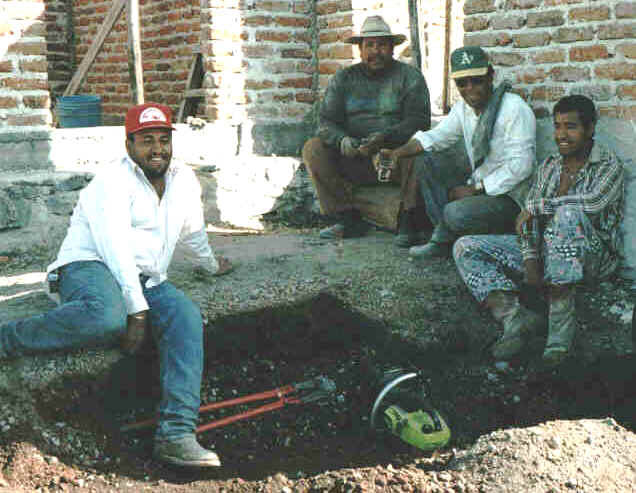From Statism to Neoliberalism
 One way of coping: "Repeasantization". Winnowing a small harvest of beans for family consumption by hand instead of using machinery, using family labour that includes a migrant son returned from the United States and a married daughter whose husband is in the US.
One way of coping: "Repeasantization". Winnowing a small harvest of beans for family consumption by hand instead of using machinery, using family labour that includes a migrant son returned from the United States and a married daughter whose husband is in the US.
Under the statist regime, the peasantry of the Ciénega reproduced itself socially by combining farming with various forms of migration, though it was international migration which became the predominant strategy for families which remained resident in rural areas, and previous patterns of seasonal migration to other parts of Michoacán, such as the cane-growing region around Los Reyes, declined in importance. There were considerable variations in the agricultural strategies pursued by different families, related to "traditional" factors in peasant economy such as disposability of family labour as well as to "non-traditional" variables like income from off-farm work.
 The eldest son of an ejidatario who became a legal worker in the USA under the provisions of the 1986 Immigration Reform and Control Act builds his house in the village, aided by a younger brother who began migrating too late to secure legal resident status, and an uncle and cousin who have long migratory careers in the North
The eldest son of an ejidatario who became a legal worker in the USA under the provisions of the 1986 Immigration Reform and Control Act builds his house in the village, aided by a younger brother who began migrating too late to secure legal resident status, and an uncle and cousin who have long migratory careers in the North
But this "peasant economy" was playing its role in an internationalized system of agricultural production: it supplied crops destined for industrial processing rather than direct human consumption; it grew those crops using machinery and agro-chemical inputs supplied by transnational companies; and it reproduced a labour force which found employment north of the border, not simply in agriculture, but in industrial and service jobs in American cities which would not have existed in the absence of a stream of cheap and relatively defenceless undocumented migrants. It was the Mexican state which underwrote this "refunctionalization" of the ejido in a changing world, but it did so in a way that ensured that the peasant farm could never achieve self-sustaining growth by accumulating a surplus for reinvestment. As the country slid into deepening general economic crisis, the neoliberal faction which gradually took control of the Mexican state found it convenient to emphasize the "dead hand" which state tutelage and "paternalism" had placed on possible peasant initiatives (as well as the vast fiscal costs of public subsidies). A new kind of debate appeared in official circles between technocrats whose hidden agenda was a rapid replacement of the ejidos by capitalist agriculture and campesinistas who adopted a more nuanced view of what made sense in the Mexican context and still clung to the idea of reforming the ejido rather than abolishing it. As things turned out, however, the basic conditions for a reformist approach, gradualism and transitional arrangements, were not to be on the agenda of a regime which was willing to sacrifice the entire agricultural sector to the exigencies of the negotiation of the North American Free Trade Agreement (NAFTA). Agricultural policy under Salinas lurched between Eastern European-style "shock therapy" and politically-motivated concessions which had little real economic significance.


 One way of coping: "Repeasantization". Winnowing a small harvest of beans for family consumption by hand instead of using machinery, using family labour that includes a migrant son returned from the United States and a married daughter whose husband is in the US.
One way of coping: "Repeasantization". Winnowing a small harvest of beans for family consumption by hand instead of using machinery, using family labour that includes a migrant son returned from the United States and a married daughter whose husband is in the US. The eldest son of an ejidatario who became a legal worker in the USA under the provisions of the 1986 Immigration Reform and Control Act builds his house in the village, aided by a younger brother who began migrating too late to secure legal resident status, and an uncle and cousin who have long migratory careers in the North
The eldest son of an ejidatario who became a legal worker in the USA under the provisions of the 1986 Immigration Reform and Control Act builds his house in the village, aided by a younger brother who began migrating too late to secure legal resident status, and an uncle and cousin who have long migratory careers in the North